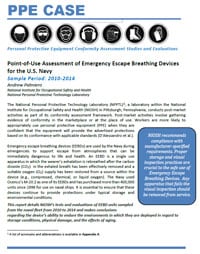PPE CASE – Point-of-Use Assessment of Emergency Escape Breathing Devices for the U.S. Navy
2018
NPPTL Report Number P2018-0105
NIOSH recommends compliance with manufacturer-specified requirements. Proper storage and visual inspection practices are crucial to the safe use of Emergency Escape Breathing Devices. Any apparatus that fails the visual inspection should be removed from service.

Emergency escape breathing devices (EEBDs) are used by the Navy during emergencies to support escape from atmospheres that can be immediately dangerous to life and health. An EEBD is a single use apparatus in which the wearer’s exhalation is rebreathed after the carbon dioxide (CO2) in the exhaled breath has been effectively removed and a suitable oxygen (O2) supply has been restored from a source within the device (e.g., compressed, chemical, or liquid oxygen). The Navy used Ocenco’s M-20.2 as one of its EEBDs and has purchased more than 400,000 units since 1998 for use on naval ships. It is essential to ensure that these devices continue to provide protections under typical storage and environmental conditions.
This report details NIOSH’s tests and evaluations of EEBD units sampled from the naval fleet from 2010 to 2014 and makes conclusions regarding the device’s ability to endure the environments in which they are deployed in regard to storage conditions, physical damage, and the effects of aging.
Suggested Citation
NIOSH [2018]. PPE CASE: Point-of-Use Assessment of Emergency Escape Devices for the U.S. Navy. By Andrew Palmiero. Pittsburgh, PA: U.S. Department of Health and Human Services, Centers for Disease Control and Prevention, National Institute for Occupational Safety and Health, NPPTL Report Number P2018-0105.
